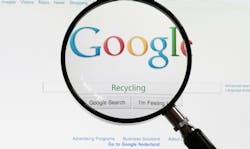Why didn’t we think of this sooner?
Google, how do we solve the plastics recycling problem?
Google answers that question with links to reputable publications, environmental groups, trade associations, universities, resin manufacturers and even LinkedIn. Missing — at least from the first two pages of results — is Google’s own research report titled “Closing the Plastics Circularity Gap.” The full report has not yet been released but an extensive executive summary was published in July. It takes a different look at plastics recycling.
Google’s study concludes that business “will lead the change toward a circular economy, as the primary designers, builders and users of materials. Business can continue to improve product and packaging design, integrate recycled materials into products and packaging and support the innovation and engagement needed to further enable a circular economy for plastics.”
The executive summary of the Google study has not received much attention, but I find it to be an even mix of alarm, data-based insight and reasonable suggestions, albeit from a 30,000-foot view. Should we care what Google thinks about recycling plastics? Yes, we should, probably more than we care about the latest report from an environmental group that uses outrageous examples to grab headlines.
Here is a very brief review.
Plastic pollution has become a problem because only about 9 percent of all plastic produced since 1950 has been recycled and returned back into the economy.
Google admits that creating a circular economy for plastics is a large and complex goal. If we continue with business as usual, the amount of plastics being recycled will triple, but the amount being landfilled, incinerated or leaked into the environment will increase even more. That is the plastics circularity gap.
But there are some positive factors, including consumer desire for increased recycling and reduced plastic waste; commitments from brands for recycling and recycled plastics; and early discussions and ongoing considerations to enact new policies to support plastics circularity.
The report has several findings, but here is the most interesting one: Infrastructure is the key to unlock the potential for plastics circularity. A Google model estimates that today’s recycling systems need to expand existing capacity by five to six times by 2040 to accommodate an increasing amount of plastic. At the same time, chemical recycling needs to expand capacity by as much as 135 times.
Forbes magazine columnist Rob Kaplan wrote that the Google study shows significant opportunities for investors.
“Business and investment will lead the way towards a solution,” Kaplan wrote in July. “With a recycling value chain that is under pressure like never before, the need for investor engagement has never been greater.
“The current challenges facing the value chain presents investors with a really unique opportunity to use their capital to steer the recycling industry back towards growth,” Kaplan said.
I hope Google and Kaplan are correct and that their optimism is well-founded. The plastics recycling industry needs more of that. In the meantime, it looks like investing in plastics recycling businesses is a pretty good bet.
Who is going to pay?
Last month we reported on Congress considering legislation to charge virgin resin makers 20 cents per pound for material used in some single-use products. That legislation is still being debated.
Now consider the first two recent state laws in Maine and Oregon that charge brand owners and importers of certain plastic products a fee to pay for recycling.
At least half a dozen other states are considering similar proposals, generally referred to as Extended Producer Responsibility (EPR) legislation. All these EPR laws are different, which could cause headaches for the supply chain.
You can read the details in this month’s Plastics Recycling magazine, published jointly by PMM and Recycling Today magazines. The story is at https://plasticsmachinerymanufacturing.com/21240670.
So who should pay? Clearly, the process of local municipalities taxing residents to pay for recycling plastic has not worked. In many cases, the cost of recycling far exceeds the value of recycled material, which forces well-intentioned local governments to choose between raising more money to make up the difference, or not recycling plastics.
Debates on federal legislation and state EPR laws are going to continue into 2022 and may have profound impacts on every sector of the plastics industry.
Ron Shinn, editor
About the Author
Ron Shinn
Editor
Editor Ron Shinn is a co-founder of Plastics Machinery & Manufacturing and has been covering the plastics industry for more than 35 years. He leads the editorial team, directs coverage and sets the editorial calendar. He also writes features, including the Talking Points column and On the Factory Floor, and covers recycling and sustainability for PMM and Plastics Recycling.

